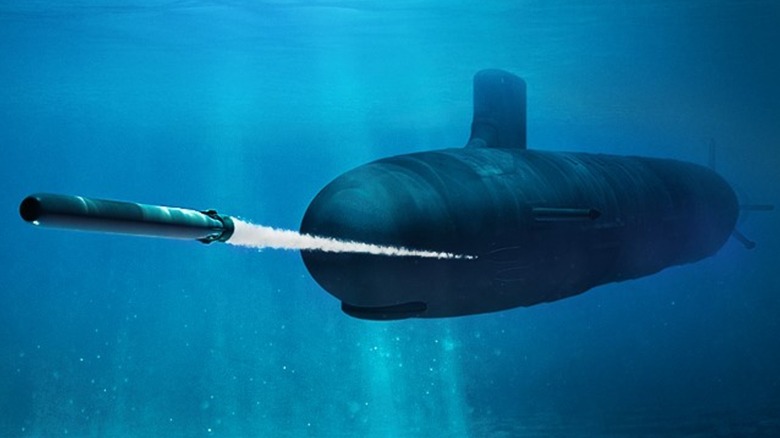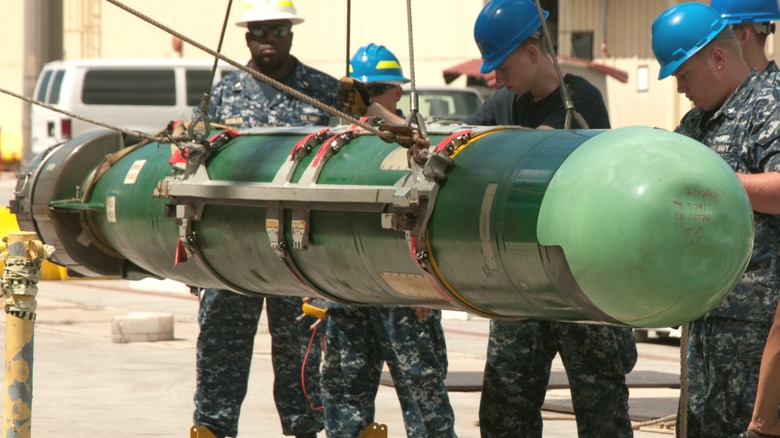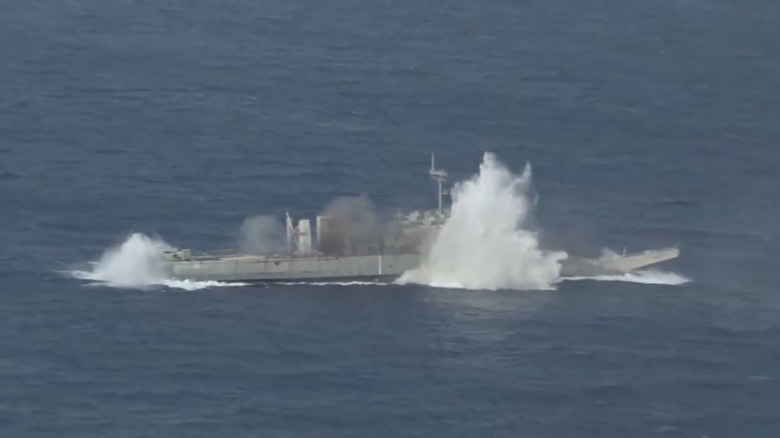What's The Deadliest Torpedo In The World And How Many Does The US Military Have?
Along with the many early submarines used prior to the 1900s, torpedoes have evolved since their inception in 1866. Today's torpedoes are vastly different than earlier examples, as they boast considerable technology and cost. Torpedoes are used to disable or destroy both submarines and surface vessels. Typically, they detonate on contact or just before hitting their target. The deadliest torpedo in the world is a massive beast capable of taking down anything that floats or swims.
The Mk 48 Advanced Capabilities (ADCAP) Heavy Torpedo is an all-digital guided weapon featuring an impressive propulsion system. It's modular and is regularly updated to ensure it remains as lethal as possible. The total amount held by the U.S. military is classified, but in 1997, the Navy swapped out its 1,046 MOD 5s for an equal number of MOD 6s. The Mk 48's most recent model is the MOD 7 Common Broadband Advanced Sonar System (CBASS), and it's the deadliest conventional torpedo ever made.
There are nuclear torpedoes, but those are in a class all their own. On the conventional side, the Mk 48 reigns supreme, and its 650-lb. High-explosive PBXN-104 warhead is more than enough to sink the world's largest ships. The Mk 48 is safe to use, deadly to be on the receiving end of, and a leading weapon in the U.S. arsenal.
The devastating capabilities of the United States' Mk. 48 Heavyweight Torpedo
The Mk 48 entered service in 1972 and has since been the primary anti-submarine/anti-surface weapon of choice for the U.S. Navy's massive submarine fleet. The MOD 7 version is the most advanced model to date. It utilizes advanced sonar for acoustic homing and has a range of 31 miles and reach speeds of 65 knots ( around 75 mph). For comparison, the fastest submarine ever built, the Soviet K-222, had a top speed underwater of 43.7 mph.
Like most torpedoes, the Mk 48 is a massive weapon, measuring 19 feet in length with a diameter of 21 inches. It weighs 3,500 pounds and can function as deep as 1,200 feet, a depth that is largely insurmountable for modern submarines. There are multiple ways to guide an Mk 48, including command by wire from the submarine, onboard active pinging sonar, or passive listening sonar, to find, fix, and engage a target.
They aren't designed to detonate on contact but to explode beneath the keel of the target, which, if done correctly, can theoretically destroy any vessel. Should an Mk 48 miss its target, it can come back around for another attempt. The MOD 7 has enhanced the torpedo's ability to operate in littoral waters. Lockheed Martin and SAIC are contracted to provide the torpedo to the U.S. military and produce around ten per month at a cost of $4.2 million per torpedo.
The Mk 48's operational history
As of mid-2025, the Mk 48 has never been fired in retaliation, nor have they been used to destroy an enemy vessels. In addition to the U.S. military, the Royal Netherlands Navy, the Royal Canadian Navy, the Brazilian Navy, and the Royal Australian Navy all use the Mk 48. Taiwan has also purchased 46 for its small fleet of Hai Kun-class attack submarines. While the weapon has yet to sink an enemy vessel in combat, the Mk 48 has been used to destroy friendly ships during U.S. Navy sinking exercises (SINKEX).
The first time this occurred was on July 23, 1988, resulting in the sinking of the decommissioned destroyer, the USS Jonas Ingram (DD-938). During the 2018 Rim of the Pacific (RIMPAC) exercise, an Mk 48 was fired at the USS Racine (LST-1191). Unlike other tests, the torpedo was fired at a great distance using a third-party vessel for targeting, effectively making any submarine an underwater arsenal.
This is because, under normal conditions, a sub might fire off as many torpedoes as it has loaded into tubes in an engagement, but by increasing the range, which protects the submarine from enemy action, it theoretically allows it to fire as many as it has onboard. Several types of ordnance were fired at the Racine, which took multiple hits, including one from an anti-ship missile. Still, it didn't sink until the USS Olympia (SSN-717) fired an Mk 48 torpedo and broke its back, sinking it within an hour.


